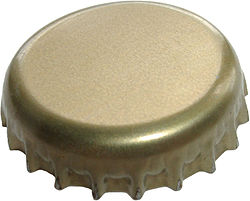This article needs additional citations for verification .(September 2020) |
A bottle cap or bottle top is a common closure for the top opening of a bottle. A cap is sometimes colorfully decorated with the logo of the brand of contents. Metal caps with plastic backing are used for glass bottles, sometimes wrapped in decorative foil. Metal caps are usually either steel or aluminum, [1] and of the crown cork type. Flip-top caps (like flapper closures) preceded such caps.
Contents
- Types
- Crown cork
- Flip-top
- Other types
- Screw cap
- Closure lining materials
- Foamed polyethylene
- Plastisol
- Pressure-sensitive liners (PS 22[citation needed])
- Polyseal cone liners
- Linerless designs – land seal (crab’s claw)
- Promotional use
- Collecting
- In popular culture
- See also
- References
- Further reading
- External links
Plastic caps are used for plastic bottles, functioning as screw caps, or plastic caps may have a pour spout rather than being detachable. Plastic caps are commonly made from polyethylene or polypropylene, [2] and caps for plastic bottles are often made of a different type of plastic from the bottle.
A cork stopper is another type of closure for the top of a bottle.

















